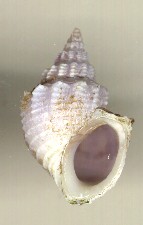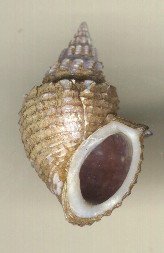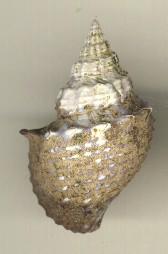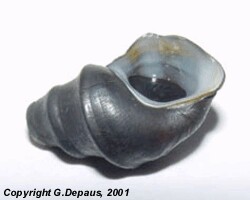|
|||||||||||||||||||||||||||||||||||||||||||||||||||||||||||||||||||||||||||||||||||||||||||||||||||||||||||||||
Freshwater Molluscan Shells / African Pleuroceridae (Potadomidae), Syrnolopsidae
Tiphobia horei E. A. Smith, 1880 Lake Tanganyika, deep water.
Central Africa has a great diversity of cerithioid snails. Zoogeographically, they can be grouped into three categories. Firstly, there are a number of widespread genera whose species inhabit rivers and lakes over large areas. Secondly, a characteristic brackish water fauna inhabits mangrove swamps along the Atlantic coast. Finally, there is a remarkable fauna of endemic seashell-like snails living in and restricted to Lake Tanganyika.
Pilsbry and Bequaert (1927) tabulate species known to them from the large African lakes (all mollusks are included).
Species,
subspecies,
and varietiesGenera Lake Total Endemic Total Endemic Albert 17 8 11 .. Edward 19 10 9 .. Victoria 69 38 19 1 Kivu 2 .. 2 .. Tanganyika 155 143 44 25 Moero 20 10 14 1 Nyasa 70 57 13 .. They classify the endemic Tanganyika genera as genera within the old all-inclusive family Melaniidae. Van Damme (1984) and Banarescu (1990) give them their own subfamily, the Paramelaniinae, which they placed in the families Thiaridae and Pleuroceridae, respectively. The actual number of species is open to question, as many of them were named by Bourguignat on the basis of what were more likely individual variations.
The nature and origin of this unique group of animals remains of interest, for instance, the following is from http://malawidrilling.syr.edu/report2.html: [offline, July 2004]
THE LAKE MALAWI [Nyasa] DRILLING PROJECT An NSF/ICDP Workshop on Scientific Drilling on Lakes Malawi and Tanganyika, October 10-16, 1999. EXECUTIVE SUMMARY, a testable hypothesis for explaining the remarkable freshwater gastropod fauna of Lake Tanganyika:
Present-day Lakes Tanganyika and Malawi [Nyasa] display strikingly different patterns of predator-prey interactions. About 240 out of 250 species of prosobranch gastropods and ostracode crustaceans in Lake Tanganyika are unique, and form numerous distinct, divergent lineages. In Lake Tanganyika, endemic crabs and fish are specialized for effective predation, and natural selection has resulted in heavily armored gastropods, remarkably convergent on thick-shelled, spinose marine snail morphologies. The gastropods deposit multiple cross-lamellar layers (up to 4) of skeletal carbonate, strengthening the shell in a fashion analogous to plywood. Furthermore, the Lake Tanganyika gastropods can repair their shells after attack (a trait rarely seen in freshwater snails, but again common in marine ones)*. [*Not correct. Evidence for broken and repaired shells is common in freshwater snails. M.K.] In contrast, none of these characteristics or interactions are well developed in Lake Malawi, where.the living prosobranch gastropod fauna has undergone only limited differentiation.
Spekia zonata (Woodward, 1859). Lake Tanganyika



Paramelania damoni, Lake Tanganyika. Specimens provided by Gerald Depaus, Belgium.
Paramelania damoni, Lake Tanganyiks. Photos of living snails courtesy of Gerald Depaus. Some of the "thalassoid" (resembling marine snails, from Greek Thalassa, sea) species pictured in Pilsbry and Bequaert (1927), included courtesy American Museum of Natural History:
Paramelania
iridescens (J. E. S.
Moore, 1898)
Lavigera grandis
(E. A. Smith, 1881)
L. coronata
Bourguignat, 1888
Limnotrochus
thompsoni
E. A. Smith,
1880
Baizea leucoraphe
(Ancey, 1890) 5 mmChytra kirkii
(E. A. Smith, 1880)
Pilsbry and Bequaert (1927) include 16 Potadoma species
plus nine additional subspecies from various rivers of the Congo Basin.
Potadoma alutacea Pilsbry and Bequaert, 1927.
Specimens courtesy of Gerald Depaus.
Potadoma superba
Pilsbry and Bequaert,
1927
Cleopatra johnstoni Smith. African lakes. Many species exist
throughout central Africa and the Nile, often variable.

Living Cleopatra johnstoni snails.
The large Pachymelanias are characteristic of brackish tidal waters and mangrove swamps along the western Africa coast. There are only three species, with many variable forms (Pilsbry and Bequaert, 1927).
Pachymelania fusca mutans, Camaroon Pachymelania aurita (Müller, 1774) Camaroon
Pachymelania fusca granifera
(Gmelin, 1791) CamaroonLiving Pachymelania fusca fusca
Native to Camaroon.
Syrnolopsidae
This family is endemic to Lake Tanganyika, where the small shells are found abundantly on beaches. A columellar fold or plait is characteristic. Pilsbry and Bequaert (1927) could not examine soft parts, but suspected it would "...turn out to be a member of the superfamily Rissoacea...." They list 10 total species in three genera. Van Damme, 1984, includes them them with the Thiaridae, in a subfamily Syrnolopsinae. More recently, Bouchet and Rocroi (2005) includes the "Syrnolopsini" as a tribe in a subfamily under the Paludomidae! Images below courtesy American Museum of Natural History.
Anceya bella
Pilsbry and
Bequaert, 1927.
9 to 11 mm.
Syrnolopsis minuta,
Bourguignat, 1885. Length
5 to 6 mm. Two specimens.
S. m. carinifera
E.A. Smith, 1889.
5 mm.
Martelia
tanganyicensis
Dautzenberg,
1908. 2.3 mm.